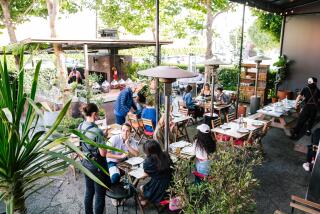Strand Brewing is tasting success after years of struggle
- Share via
Two surfing buddies who created one of Southern California’s fastest-growing microbreweries have advice for anyone eager to follow in their steps. Don’t do it. Seriously, dude. Don’t.
Joel Elliott and Rich Marcello built Strand Brewing Co. in a tiny space at a Torrance industrial park by working 100-hour weeks for three years, without vacation or pay or employees.
They borrowed money from relatives and friends. Then they hit them up again, and again, and again. They tapped out their own credit cards.
Money was so tight in 2010 that when Marcello loaded kegs into his nicked-up ’98 Chrysler van to make deliveries, Elliott would think: “Just don’t crash.” A wreck might finish them.
Marcello never crashed — and Strand’s by-tap-only beers are now served in more than 200 bars, restaurants and hotels across Southern California, including places as diverse as Wolfgang Puck Bar & Grill at L.A. Live, the Ritz-Carlton in Marina del Rey, and craft beer meccasFather’s Officeand Beachwood BBQ & Brewing.
Sales nearly tripled the second year to $309,000 and are on pace to hit $750,000 in 2012. The partners hired their first employee in April, an assistant brewer, and have signed with a distributor, Wine Warehouse — freeing Marcello from making every sale and delivering every keg from his van.
It’s all quite nice. But getting there? In Elliott’s word, insane, especially for two guys whose knowledge of beer had been: “We drank a lot of it.” Even the idea of opening a brewery was something of an accident.
As Elliott recalled, the idea for Strand came via a misunderstanding. He and Marcello had a third friend, an avid home brewer who dreamed of starting a microbrewery — someday.
The home brewer’s wife talked to Elliott’s wife one day late in 2008 and afterward, Elliott’s wife told him his friend wanted to open a brewery — now.
Elliott jumped at the idea, discovering only later that something had been lost in translation. The home brewer had no immediate plans.
But Elliott pushed on, persuading Marcello to join him.
Neither had a business background. They had no business plan, no budget. “Nope, we just knew we had to get some money,” Elliott said.
Friends and relatives put up about $85,000, in return for promises to repay at 7% interest. The partners leased a unit in Telo Industrial Center in April 2009 and began converting it into Strand, taken from the name locals give to the pathway lining the beaches of the South Bay.
Kevin Day, beer manager for Wine Warehouse, said the partners had two things going for them at the start: smarts and luck. Both were evident as Strand caught the craft beer wave, he said.
The industry, born in Northern California in the 1970s, took flight in Los Angeles only in the last four or five years. The market here is young and growing fast, said Paul Gatza, director of the Brewers Assn., a craft beer industry group headquartered in Colorado.
The rising demand means opportunities for Strand and the roughly 20 other microbreweries operating in Los Angeles, Orange, Riverside and San Bernardino counties. Those are all craft beer breweries, which means they meet certain industry standards, chiefly that they are independently owned and small.
That certainly describes Strand three years ago, when it was all of 1,000 square feet.
Elliott and Marcello started by dividing responsibilities to match their wildly different personalities. It turned into a sound business decision. “If you have two Riches or two Joels, this doesn’t work,” Day said.
Elliott, 36, is solitary, lean of speech and likes to make things with his bare hands. The son of a handyman, he built much of the brewery — carpentry, plumbing, wiring and so on.
He is president — and brewer, government liaison, and the maintenance and art departments.
Marcello, 44, is Strand’s irrepressible front man, with an ease among strangers, a salesman’s savvy and knowledge drawn from decades as a bar and restaurant manager.
He is vice president — and sales, distribution, promotion, and accounts payable and receivable.
After five months squaring away the brewery, the pair were ready for their first brew in September 2009. The partners used the only fermenters they could afford — small ones, each capable of producing seven 31-gallon barrels.
They chose a pale ale home recipe and multiplied for the larger volume. It was an unfortunate choice, or so it seemed initially. “It turns out, you can’t just scale up a home recipe,” Elliott said with a wry smile.
Accidentally, they had cooked up an IPA, the popular shorthand for India pale ale, an intense brew with more alcohol and hops than a pale ale. Instead of classifying it, they slapped on the name Genesis and prepared for a coming-out party.
Marcello targeted the popular Naja’s Place on the Redondo Beach Pier. Assistant General Manager Martin Svab said he took an instant liking to Marcello and, because the bar believes in supporting local brewers, agreed to buy one 15.5-gallon keg for $135.
Marcello pushed for more. “What if people who like it Saturday come back Sunday for football?”
Svab eventually tripled the order, which meant that at a bar with 87 competing taps Strand would try to sell 46.5 gallons of an unknown beer. Svab said his boss thought, “Are you out of your mind?”
The event started at 1:30 p.m on Saturday, Oct. 17, 2009. The third keg was drained by 11. Never mind that 50 friends and relatives had been among the customers. Marcello had a narrative he could use to wedge Strand into more bars, which isn’t easy.
“To put up our tap, they have to take someone else’s down,” and possibly reprint their menus, Elliott explained.
Simmzy’s pub in Manhattan Beach became account No. 2, and the beer sold swiftly. Owner Mike Simms said he agreed to buy that first keg because Marcello was sincere and “had the right ideals,” a word often heard in the industry. Aficionados want their beer made by brewers they believe are devoted to craft first, money second.
As a former bar manager, Marcello knew that microbreweries generally fail for one of three reasons: lousy beer, bad marketing or unreliable service. So he marketed relentlessly, the only way he could afford: one-on-one. After delivering a keg and hooking it up, he often returned to the bar at night to chat up patrons and buy them Strand brews — essentially paying twice for each beer, once as raw ingredients and labor, and again from the tap.
Aware that bartenders recommend beers to patrons, Marcello made them his primary target, always returning texts and phone calls immediately.
He recalled sitting in a movie in Torrance one night with his wife. A bartender in downtown L.A. texted that the Strand tap wasn’t pouring. Marcello left the movie, took his wife home and drove downtown.
By May 2010, Strand had about 25 accounts. Soon, the brewery topped out in capacity — and was still losing money.
Elliott’s family scraped by because his wife worked, which allowed him to all but live at the brewery. (He went from Strand to the hospital for the birth of the couple’s third child in 2009.)
Marcello’s wife was in graduate school at Pepperdine University, so he had taken a 5 a.m. to 1 p.m. job dealing with East Coast clients for Elliott’s uncle’s public relations firm. The schedule freed up his afternoons, nights and weekends for Strand.
Elliott had known from the beginning that the small fermenters couldn’t produce enough beer for the brewery to survive. By mid-2010, Strand needed more capacity. Back to the friends and relatives.
“My uncle gave me his retirement money,” Elliott said. “Yeah, no pressure.”
Strand added three 15-barrel fermenters for about $12,000 apiece. At that point, Marcello no longer had time for his day job. He quit and began drawing just enough salary from Strand to get by.
It paid off. By the middle of 2011, the number of accounts topped 100 and the brewery was nearing capacity again — and still not making money.
Back to the usual suspects for more loans, pushing total debt to just over $300,000 but raising enough for a major expansion. Strand converted an adjoining unit at the industrial park and in January added three 60-barrel fermenters, each about two stories tall.
The expansion drove capacity to 3,900 barrels from 462 in 2010, establishing Strand as mid-sized among the more than 2,000 microbreweries operating in the United States, said Gatza of the Brewers Assn. In April, Strand added a tap room at the brewery, open Thursday through Sunday afternoons and evenings. Hundreds of people come each week to mingle with the owners, sip a variety of beers and inhale the brewery’s nutty, caramel scent.
Strand turned the corner. The partners are now drawing salaries and Elliott predicts that all loans will be paid within 14 months.
The van is for sale.
Gatza said Strand’s journey, while arduous, is fairly typical. Fledgling microbreweries prefer to borrow from friends and families, not banks, and to start by selling in kegs to avoid the expense of bottling or canning lines.
Looking back, Elliott said the struggle made them work smarter than if they had had full financing at the start. “If you have the money, that money means you don’t have to be creative.”
As evidence, he notes that tap handles for many craft breweries cost $40 or more. Strand’s first handles were made with flooring left over from Elliott’s house, for about $5 apiece.
As for other would-be brewers, Elliott’s advice is: “Don’t do what we did. We are insane.”
More to Read
Inside the business of entertainment
The Wide Shot brings you news, analysis and insights on everything from streaming wars to production — and what it all means for the future.
You may occasionally receive promotional content from the Los Angeles Times.







